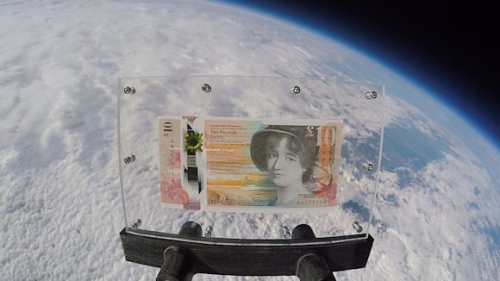By Hamish Johnston and Matin Durrani
Primary school children in Scotland have celebrated the launch of a new £10 note by launching it into space. Well, sort of. The Royal Bank of Scotland note was actually sent aloft on a high-altitude balloon with a camera to capture the event for posterity.
If you know your astronomers, you will recognize Mary Sommerville on the tenner. She was active in the early 19th century and famously predicted the existence of Neptune by its influence on the orbit of Uranus. She and Caroline Herschel were the first women to be members of the Royal Astronomical Society and she also wrote the bestselling science book On the Connexion of the Physical Sciences.
There is much more about Sommerville in our podcast “Mary, Queen of Scottish banknotes“.
“The Nobel Prize for Physics went to three men, but the paper describing their discovery lists 1000 authors. What gives?” So asks Nicole Kobie in Wired. Her article delves into the machinations that ensured that the right 0.3% of the LIGO collaboration are going to Stockholm. See “You can’t give a Nobel prize to a thousand people. Here’s why“.
There was a fascinating tale by Carl Zimmer in the New York Times this week about the curious medical symptoms that recently struck nearly two dozen diplomats at the American embassy in Havana, Cuba. Ranging from hearing loss to cognitive difficulties, the problems were so serious that the US State Department concluded that the staff were the victims of a stealth attack. It also withdrew non-essential personnel from Havana, and even advised Americans not to visit. But according to Zimmer’s report, US government officials have suggested anonymously that the diplomats may have been assaulted with some sort of sonic weapon, possibly in their homes.
Well, we know that the Pentagon has funded the development of loudspeakers to ward off pirates with long-range blasts of sound, but presumably if sound had been used in Havana, we’d have heard it. In that case, could infrasound, which lies below the frequency of human hearing, or ultrasound, which lies above it, have been deployed? Both are unlikely, according to acoustical physicists and others quoted by Zimmer, but ultrasound is the less implausible option of the two. For example, Steven Garrett, who taught acoustics at Penn State University before retiring last year, says he used to demonstrate ultrasound beams to his students. Garrett says he’d get nauseous and develop a headache; eventually he took to wearing earmuffs and earplugs. It’s “anecdata” for sure, but Zimmer’s article makes intriguing reading.

Guidelines
Show/hide formatting guidelines
this text was deletedwhere people live in harmony with nature and animals</q>
Some text